
Hornsea Museum is a local museum in Hornsea, East Riding of Yorkshire, northern England. [1]

Hornsea Museum is a local museum in Hornsea, East Riding of Yorkshire, northern England. [1]
The museum was established in 1978. It is housed in an 18th-century farmhouse and two cottages. The museum is a registered charity (No. 509615) and is largely run by volunteers. The museum is a member of the Holderness museums collaboration.
The farmhouse was occupied by the Burn family for almost 300 years. [1] The museum presents Victorian rural life and local history concerning north Holderness. [2] Rooms present life in Victorian times, including a bedroom, the dairy, kitchen, parlour, and wash-house.
Outside the farmhouse, set in a large garden, are a barn, craft workshops, a Victorian school room and a Victorian street scene. In addition, there is an exhibition room showing militaria and another exhibiting childhood and toys. The Whitedale building has displays on the history of the Hull and Hornsea Railway and Hornsea's fishing heritage.
The cottages have exhibition rooms containing some 2,000 items of Hornsea Pottery. [3]

Temple Newsam, is a Tudor-Jacobean house in Leeds, West Yorkshire, England, with grounds landscaped by Capability Brown.
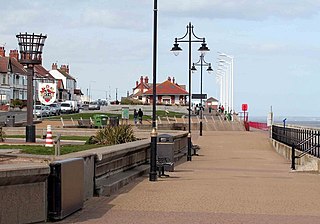
Hornsea is a seaside town and civil parish in the East Riding of Yorkshire, England. The settlement dates to at least the early medieval period. The town was expanded in the Victorian era with the coming of the Hull and Hornsea Railway in 1864. In the First World War the Mere was briefly the site of RNAS Hornsea Mere, a seaplane base. During the Second World War the town and beach was heavily fortified against invasion.

Llantwit Major is a town and community in Wales on the Bristol Channel coast. It is one of four towns in the Vale of Glamorgan, with the third largest population after Barry and Penarth, and ahead of Cowbridge. It is 4+1⁄2 miles (7.2 km) from Cowbridge, 9 miles (14 km) from Bridgend, 10 miles (16 km) from Barry, and 15 miles (24 km) from Cardiff. It had a population of 9,486 in 2011.
Dorneywood is an 18th-century house near Burnham in southern Buckinghamshire, England. Originally a Georgian farmhouse, it has Victorian and later additions, and following a fire in 1910, was remodelled in 1919 by Sir Robert Lorimer.

The Colne Valley Museum is located within the Colne Valley at Golcar, Huddersfield, West Yorkshire, England. The museum consists of four converted 19th century weavers' cottages. The museum provides an insight into what life was like for a weaver in the early 1850s. The museum includes a clog maker's workshop, a handloom chamber, a spinning room, a cropping room, kitchen and living rooms. The museum is run entirely by voluntary members.

Sudley House is a historic house in Aigburth, Liverpool, England. Built in 1824 and much modified in the 1880s, it is now a museum and art gallery which contains the collection of George Holt, a shipping-line owner and former resident, in its original setting. It includes work by Thomas Gainsborough, Joshua Reynolds, Edwin Landseer, John Everett Millais and J. M. W. Turner.

Hull Paragon Interchange is a transport interchange providing rail, bus and coach services located in the city centre of Kingston upon Hull, England. The G. T. Andrews-designed station was originally named Paragon Station, and together with the adjoining Station Hotel, it opened in 1847 as the new Hull terminus for the growing traffic of the York and North Midland (Y&NMR) leased to the Hull and Selby Railway (H&S). As well as trains to the west, the station was the terminus of the Y&NMR and H&S railway's Hull to Scarborough Line. From the 1860s the station also became the terminus of the Hull and Holderness and Hull and Hornsea railways.

The Food Museum, formerly the Museum of East Anglian Life, is a museum in Stowmarket, Suffolk, England, which specialises in presenting the agricultural history of East Anglia through a mixture of exhibits and living history demonstrations.
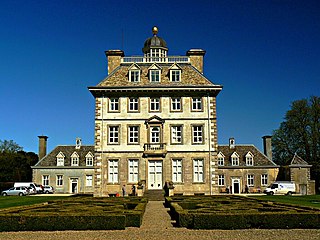
Ashdown House is a 17th-century country house in the civil parish of Ashbury in the English county of Oxfordshire. Until 1974 the house was in the county of Berkshire, and the nearby village of Lambourn remains in that county.

The Museum of East Dorset is a local museum in the town of Wimborne Minster in Dorset, England. It is located on the high street, opposite the Church of Wimborne Minster. The museum occupies a historic Grade II* listed building, a hall house dating from the late 16th or early 17th century.
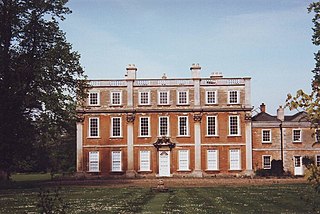
Hinwick House is a Grade I-listed Queen Anne country house located about 90 minutes from Central London, near Podington in North Bedfordshire. The estate consists of the Queen Anne main house, the Victorian wing, the Victorian wing extension, garage block, stables, three cottages attached to a clock tower, a walled garden and a period dovecote. The house and estate has a total of 50 rooms. Hinwick House underwent a two-year restoration programme that concluded in 2016.

Fairfield Museum and History Center is a museum and library located at 370 Beach Road in Fairfield, Connecticut. Established in 2007 by the 103-year-old Fairfield Historical Society, the Fairfield Museum's vision is to use history to strengthen community and to shape its future. The 13,000 square-foot museum features exhibition galleries, a special collection research library and reading room, a family education center, an 80-seat theater overlooking Fairfield's Town Green and a museum shop.

Summerlee Museum of Scottish Industrial Life is an industrial and social history museum in Coatbridge, North Lanarkshire, Scotland. It is situated on the site of the Victorian Summerlee Iron Works and the former Hydrocon Crane factory. The main Hydrocon factory building became the museum’s exhibition hall but it has been substantially changed and adapted since. The museum aims to show Lanarkshire's contribution to engineering, mining, steel working, weaving and farming, and also show the lives of the people of the area. It includes interactive displays and a temporary exhibition space. Entry is free of charge.

Dungworth is a hamlet in the civil parish of Bradfield, west of Sheffield in South Yorkshire, England.

Ilkley Manor House, Ilkley, West Yorkshire, England, is a local heritage museum, art gallery, and live venue, and was established in the present building in 1961 to preserve local archaeological artefacts after the spa town expanded and much Roman material was lost. It was managed by Bradford Council Museums and Galleries department but had to be closed in 2013 owing to lack of funds. In order to keep the building open to the public, the Ilkley Manor House Trust was formed, and in April 2018, Bradford Council transferred the Manor House and three adjacent cottages to the Trust as a community asset transfer.

Cliffe Castle Museum, Keighley, West Yorkshire, England, is a local heritage museum which opened in the grand, Victorian, neo-Gothic Cliffe Castle in 1959. Originating as Cliffe Hall in 1828, the museum is the successor to Keighley Museum which opened in Eastwood House, Keighley, in c. 1892. There is a series of galleries dedicated to various aspects of local heritage, and to displaying the house itself, which is a Grade II listed building. Entrance to the museum is free of charge.

Bracken Hall Countryside Centre and Museum is a children's museum, natural history education centre and nature centre established in 1989 at Bracken Hall on the edge of Baildon Moor, close to Shipley Glen in West Yorkshire, England.
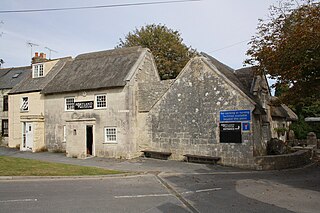
Portland Museum is a museum on the Isle of Portland in Dorset, southern England. It is located at the southern end of the hamlet of Wakeham. The museum is housed in two 17th-century thatched cottages, which have both been Grade II Listed since 1951. One of the museum's cottages, Avice's Cottage, is featured in Thomas Hardy's 1897 novel The Well-Beloved, as the home of three generations of "Avices" - the novel's heroines.

The Widows' Almshouses, also known as the Wilbraham or Wilbraham's Almshouses and as the Widows' Hospital, are former almshouses for six widows in Nantwich, Cheshire, England. They are located at numbers 26–30 on the north side of Welsh Row, on the junction with Second Wood Street. The almshouses were founded by Roger Wilbraham in 1676–7 in memory of his deceased wife in three existing cottages built in 1637; they were the earliest almshouses in the town for women. In 1705, Wilbraham also founded the Old Maids' Almshouse for two old maids in a separate building on Welsh Row. They remained in use as almshouses until the 1930s. The timber-framed Widows' Almshouses building, which is listed at grade II, has subsequently been used as a café, public house, night club, restaurant, wine bar and hotel.
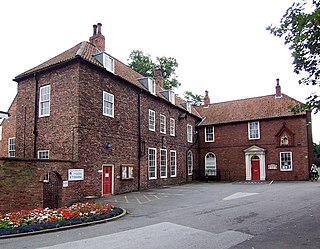
Baysgarth House Museum is a local museum located in Baysgarth House, situated in Baysgarth Park, in the market town of Barton-upon-Humber, Lincolnshire, England.